eISSN: 2379-6367


Research Article Volume 4 Issue 6
1School of Pharmacy, BBD University (Earlier Faculty of Pharmacy, Babu Banarasi Das National Institute of Technology & Management), India
2Ex Deputy Director, Central Drug Research Institute (C.D.R.I.), India
Correspondence: Rajiv Gupta, Prof. & Dean, School of Pharmacy, BBD University (Earlier Faculty of Pharmacy, Babu Banarasi Das National Institute of Technology & Management), Dr. Akhilesh Das Nagar, Lucknow-226 028, UP, India, Tel 91 9839278227
Received: June 18, 2016 | Published: December 22, 2016
Citation: Gupta R, Singh HK. Detection and quantitation of gallic acid in Alternanthera sessilis and Clerodendrum infortunatum by HPTLC. Pharm Pharmacol Int J. 2016;4(6):467-471. DOI: 10.15406/ppij.2016.04.00097
Objective: Gallic acid is an organic acid found in a variety of foods and medicinal plants that are well known as powerful antioxidants, and have along history of usage traditionally. Many Foods, herbs and tea all contain Gallic acid. Gallic acid is also found in gall nuts, sumac, witch hazel, watercress, oak bark, and a variety of other plants and herbs, also found in important Indian Medicinal Plants like Alternanthera sessilis and Clerodendrum infortunatum as mentioned in Ayurveda, in intellect enhancing preparations, later explored as part of tannins, which are astringent, bitter plant polyphenols. The age old Indian System of Medicine, i.e. Ayurveda is based on traditional way of maintaining a healthy lifestyle and living in sync with the nature, thereby reducing or delaying the onset of any degrading/diseased condition involving neurological disorders. Leaves of Alternanthera sessilis (Family Amaranthaceae) and Clerodendrum infortunatum (Family Verbenaceae) have been mentioned in Ayurveda but have not been fully explored scientifically.
Materials and Methods: It was thought worthwhile to generate experimental data on the plant material so as to explore some markers present in these plants, like Gallic Acid, which may be useful for future ready reference and may also serve as a parameter in Standardization and Quality Control/Adulteration studies. Gallic Acid has already captured researchers interest due to its effect on nervous system.
Results: The concentration of Gallic Acid in leaves of Alternanthera sessilis and Clerodendrum infortunatum was found to be 8.022µg/mL and 8.54µg/mL respectively.
Conclusion: The Data thus generated in present research work may be of use in future studies involving development of standardization/adulteration/substitution parameters on Alternanthera sessilis & Clerodendrum infortunatum. It is known that the present day lifestyle invariably results in Oxidative stress which results in an imbalance between high consumption of oxygen and low levels of endogenous antioxidants. It is known that Gallic acid (GA) is a strong antioxidant. It is pertinent to state that Gallic Acid may be considered as a marker for future studies on medicinal plants, related to Neuropsychopharmacological investigations mainly involving oxidative stress.
Keywords: Alternanthera sessilis, Clerodendrum infortunatum, gallic acid
The plant Clerodendron viscosum Vent. (Synonym: Clerodendrum infortunatum Gaetrn.) Family Verbenaceae known as Bhandirah in Sanskrit (Bhant in Hindi) is an important plant in Indian system of Medicine.1 It is an indigenous medicinal plant widely distributed in various parts of India, Ceylon, Malaya and Bangladesh.2 In Indian folk medicine the plant is used in the treatment of bronchitis, asthma, fever, diseases of the blood, inflammation, burning sensation and epilepsy.2 The plant is used in convulsions, cramps, sores, ulcers & gravel;3 used as bitter tonic and antiperiodic, vermifuge, pain killer, laxative and cholagogue;4‒7 in scorpion-sting & snake-bite;3,4,6 used externally against tumors and skin disease.4,7 Apart from its application as antipyretic and antihelmentic in ethnic medicine, it is also used for relieving thirst and burning sensation, foul odors, and diseases of the blood.8 Alternanthera sessilis (L.) DC. (Sessile joy weed), is a popular leafy vegetable. Its leaves and young shoots are eaten as vegetable or cooked in soup in Sri Lanka and also used as traditional medicine in China, Taiwan and India. A. sessilis is known as Matsyakshi in Ayurveda. It has been used in Indian traditional system of medicine since a long time in diseases due to vitiated blood, skin diseases and ulcers.9
The present investigations presents chromatographic fingerprints of Clerodendrum infortunatum and Alternanthera sessilis leaves developed by HPTLC using Gallic acid as marker compound. An attempt has been made to quantify the amount of Gallic Acid present in the said plants, by using HPTLC as it provides a rapid quick and precise method of detection in comparison to conventional methods like UV and GC (Figure 1).
Plant material
Leaves of Clerodendrum infortunatum and Alternanthera sessilis were collected from local areas of Lucknow, Uttar Pradesh and identified and authenticated by Dr. A. K. S. Rawat, Sr. Principal Scientist, Division of Pharmacognosy and Ethnopharmacology, National Botanical Research Institute (N.B.R.I.-C.S.I.R.), Lucknow; also a voucher specimen was submitted for future reference (Ref No. NBRI/PH/4-5-1/51).
Chemicals
All chemicals used for the study were of analytical grade and the reference standard (Gallic acid) was obtained from SD Fine Chemicals, Mumbai, India, through an authorized institutional supplier M/S Sohan Lal & Sons.
HPTLC plates, 10 x10cm, pre-coated with silica gel F254 (Merck) were used.
Sample solution
Since the marker compound were soluble in Methanol, methanolic extract was prepared by accurately weighing 50gm of size reduced air dried powdered plant material (leaves) and was defatted with Petroleum ether and then Soxhlet extracted with Methanol for 16 hours. The methanolic extract was filtered through Whatman filter paper, filtrates were combined, concentrated under vacuum and the extract thus obtained was used for the quantification of Gallic acid.
Standard solution of gallic acid
10mg of Gallic Acid were dissolved in methanol and the volume was made up to 100ml with methanol.
Solvent system
The best resolution was observed in the following solvent system and was selected for the present study:
Toluene: Ethyl Acetate: Formic Acid (5: 5.5: 1).10
Quantification of Gallic Acid using HPTLC
Preparation of stock solutions
Preparation of gallic acid standard solution: A stock solution of standard Gallic acid was (100µg/mL) was prepared by transferring 10mg of Gallic Acid in 100mL Volumetric flask and the volume was made up to the mark with Methanol. Further dilutions were made with Methanol to obtain working standards 20, 40, 60, 80 and 100μg/mL.
Preparation of test sample: 10mg of concentrated methanolic extract of Alternanthera sessilis and Clerodendrum infortunatum was redissolved in 10mL of Methanol to obtain a test sample (1000µg/mL).
Preparation of calibration curve of gallic acid: The TLC plate was activated by placing it in an oven at the temperature of 110°C for 20min. the spots were applied to the plates with test and prepared standard solution maintaining a distance of 15mm from the edge of TLC plate. It was developed up to 75mm in the twin trough chamber using mobile phase, was dried in an oven and subjected for TLC scanning at 254 nm. The area of the resolved peaks was recorded. Calibration Curve of Gallic Acid was obtained by plotting peak area versus concentration of applied standard i.e. Gallic Acid (Table 1).
S. No. |
Start Position |
Maximum RF |
End Position |
AUC |
Track 1 |
0.82 |
0.89 |
0.91 |
5785.3 |
Track 2 |
0.82 |
0.89 |
0.91 |
5997.4 |
Track 3 |
0.82 |
0.89 |
0.91 |
6864.1 |
Track 4 |
0.82 |
0.88 |
0.91 |
7718.4 |
Track 5 |
0.82 |
0.87 |
0.91 |
8621.3 |
Track 6 |
0.82 |
0.87 |
0.9 |
10709.6 |
Track 7 |
0.82 |
0.87 |
0.91 |
11091.2 |
Table 1 Rf Range and AUC of Standard Gallic Acid (Track 1-5), Alternanthera sessilis (Track 6) and Clerodendrum infortunatum (Track 7)
Under the chromatographic conditions described above, the RF value of gallic acid was about 0.89 in leaves of Alternanthera sessilis and Clerodendrum infortunatum. The respective Rf’s obtained from each track is shown in Table 1. The Chromatograms of standard gallic acid are shown in Figure 2 (A-E) and that of gallic acid in leaves of Alternanthera sessilis and Clerodendrum infortunatum are shown in Figure 3A and 3B respectively. Spectral Comparison of gallic acid (reference standard) with gallic acid present in Alternanthera sessilis and Clerodendrum infortunatum is shown in Figure 4. The 3D spectra of all tracks scanned at 254nm are shown in Figure 5. The calibration curve was linear in the range of 20 to 100μg/mL, as illustrated in Figure 6. From the regression equation y=739.3x+4779.4, the concentration of Gallic Acid in leaves of Alternanthera sessilis and Clerodendrum infortunatum was found to be 8.022µg/mL and 8.54µg/mL respectively. This data would be of use while establishing standardization parameters of selected plants, which may also be of use as a reference in studies involving adulteration/substitution.
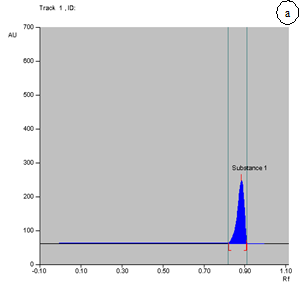
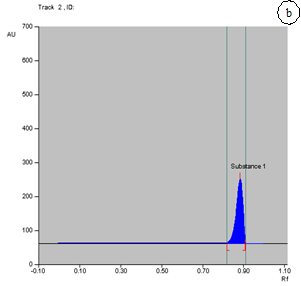
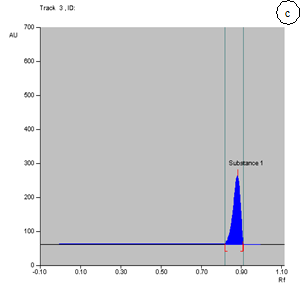
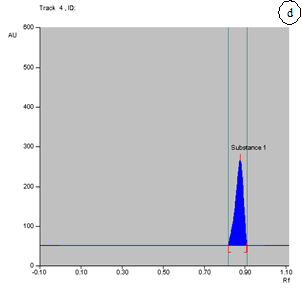

Figure 2 A Typical HPTLC chromatogram of Gallic acid working standard (A) Track 1 (20μg/mL) (B) Track 2 (40 μg/mL) (C) Track 3 (60 μg/mL) (D) Track 4 (80 μg/mL) (E) Track 5 (100 μg/mL).
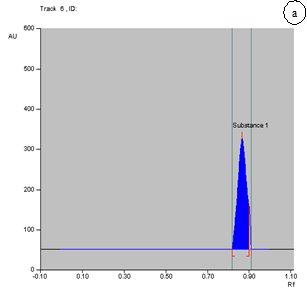

Figure 3 A Typical HPTLC chromatogram of Gallic acid in leaves of Alternanthera sessilis (3A) and Clerodendrum infortunatum (3B).
Looking into the potential health benefits that Gallic Acid is offering like protective effect in Neural Degeneration, protection from Sun Damage effective in Liver Fibrosis, in Inflammation & Cancer. Today, Studies have shown that Gallic acid is effective in inhibiting neuronal death. Studies have also shows that Gallic acid has anti-cancer properties against leukemia, certain prostate, colon and lung cancer cells. Gallic acid has been shown to prevent cellular mutations and to be toxic to cancer cells, while having no negative effect on healthy cells. This, of course, means that Gallic acid may prove to be an effective treatment for certain forms of cancer, and that increasing the amount of Gallic acid consumed may help those suffering from cancer in their fight against the disease. In addition to the health benefits for people at risk for certain forms of cancer or neural disorders, Gallic acid also has anti-viral and anti-fungal properties. It is a powerful antioxidant that helps to prevent oxidative damage. Gallic acid also has therapeutic applications for inflammatory allergic diseases, such as asthma, allergic rhinitis, sinusitis due to its ability to inhibit histamine release and the expression of pro-inflammatory cytokine.11
Finally, Gallic acid can be used as a remote astringent, as it works to constrict tissues and stop bleeding. Administered internally, Gallic acid has shown to be an effective astringent that is beneficial in the treatment of uterine, pulmonary, and nephritic hemorrhages, as well as all hemorrhages of a passive character. As a remote astringent, Gallic acid has also proved to be effective in the treatment of regular, unusually heavy and prolonged menstrual periods (also known as Menorrhagia). In fact, Gallic acid has shown to cease the occurrence of Menorrhagia when the individual takes 5 grains of Gallic acid in pill-form 3–4times per day during the flow. It is generally agreed that most of the phenomena observed during brain ischemia and reperfusion can be explained by the damage to membrane structure. Oxidative stress is resulted in an imbalance between high consumption of oxygen and low levels of endogenous antioxidants. It is known that gallic acid is a strong antioxidant. The present study was carried out to detect and quantify gallic acid on two important medicinal plants Alternanthera sessilis and Clerodendrum infortunatum, mentioned in Indian System of Medicine i.e. Ayurveda, and thereby attempt would be made to validate its claims its usage in neurosychopharmacological disorders.
The authors are thankful to Prof. (Dr.) Shubhini A. Saraf for providing all the necessary laboratory facilities. The corresponding author is also thankful to AICTE-MODROBS grant (F. No. 8024/RID/BOR/MOD-458/2009-10) for making the research work possible on selected plants; also acknowledge the contribution of Hafsa Ahmad and Sakshi Sehgal (M.Pharm. Pharmacognosy Research Scholars) in preparation of the manuscript.
Author declares that there is no conflict of interest.

©2016 Gupta, et al. This is an open access article distributed under the terms of the, which permits unrestricted use, distribution, and build upon your work non-commercially.